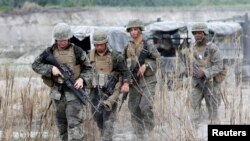The United States military is scaling back its counter-terrorism assistance program in the southern Philippines after more than a decade of regular rotations. The move comes despite persisting security threats in the region.
U.S. government officials say their work with the Armed Forces of the Philippines has been “successful at drastically reducing the capabilities of domestic and trans-national terrorist groups.”
Casey Staheli, the U.S. spokesman for the Joint Special Operations Task Force-Philippines (JSOTF-P), says the groups have devolved into criminal elements.
“The time has come to re-evaluate our position here and how best we can continue to support the Philippine security forces. So, with that in mind, military planners from both the United States and the Philippines are looking at ways to adjust our presence as far as the JSOTF-P goes,” says Staheli.
He says the focus is now shifting from helping with on-the-ground tactical efforts to strategy and planning. According to Staheli, there are 320 U.S. troops with the task force. A smaller contingent of high-ranking officials will be involved in the strategic work.
A year after the September 11 terrorist attacks in the United States, the U.S. started rotating troops to the southern island Mindanao, whose smaller island provinces are home to a terrorist group with links to al-Qaida.
The Abu Sayyaf Group (ASG) was once notorious for large-scale bombings. But in the past 12 years its ranks dwindled to a few hundred as military operations intensified with U.S. troop support. Also, its funding source dried up when terror financing was blocked worldwide. The ASG dropped its ideological motives and became known for kidnappings for ransom, beheadings and bombings.
Regional, domestic threats persist
Matt Williams, the Philippine country director for the business risk consultant group Pacific Strategies and Assessments, says as the United States scales back its counter-terrorism program here, there is still a terror threat in neighboring Malaysia and Indonesia.
“Does the Philippine military and intelligence services have the capacity right now to continue to contain these groups from spreading into the Philippines, or will a lot of the successes of the last 10 years be lost?” – asks Williams.
Carl Baker with the Washington-based Center for Strategic and International Studies says the government and the country’s largest Muslim rebel group have made important progress in working on a newly-signed peace pact to form an autonomous area in the south. But he says domestic threats still remain.
“There are still a lot of loose ends that need to be tied up. And in any situation like the long-standing conflict that’s been going on in the southern Philippines, you have these splinter groups, these spoiler groups that can still cause disruption,” says Baker.
Protracted tensions
For nearly 40 years Muslims in Mindanao fought government forces in an insurgency that left more than 120,000 people dead. After 16 years of off-and-on negotiations, the Moro Islamic Liberation Front forged a peace deal with the government. But several other Muslim factions oppose the agreement.
Last September, Philippines forces fought a faction of the Moro National Liberation Front for weeks after it held 200 people hostage in the city of Zamboanga. The Bangsamoro Islamic Freedom Fighters continue bombing operations against the military. And a tiny group calling for an Islamic caliphate is believed to have forged an alliance among the Indonesia-based Jemaah Islamiyah and other Philippine militant groups.
Rodolfo Mendoza, a terrorism expert at the Philippine Institute for Peace, Violence and Terrorism Research, says these smaller groups are banding together.
“The peace process is still a closed door to them. They are considered terrorists and so they have to maximize their plan of terrorist operations. And now they are doing that,” says Mendoza.
Mendoza says bomb-making and other militia training continues among those groups.
But with the success in Zamboanga behind it, the Philippine Armed Forces, which has one of the smallest military budgets in Asia, says it has the experience to handle such threats.
Upbeat outlook
Armed Forces Spokesman General Domingo Tutaan says the change in the U.S. counter-terrorism program will not affect Philippine military operations in the south.
“They (JSOTF-P counterparts) have been undertaking also training of trainers so that transfer of knowledge and expertise is still going to be ongoing,” says Tutaan.
Baker says the transition also follows the Philippines’ own shift to focus more on protecting its territory and dealing with outside threats. Its military modernization program is heavily geared toward bolstering external defense.
U.S. military spokesman Casey Staheli says the Joint Special Operations Task Force in the Philippines will “cease to exist” in the first half of 2015.






